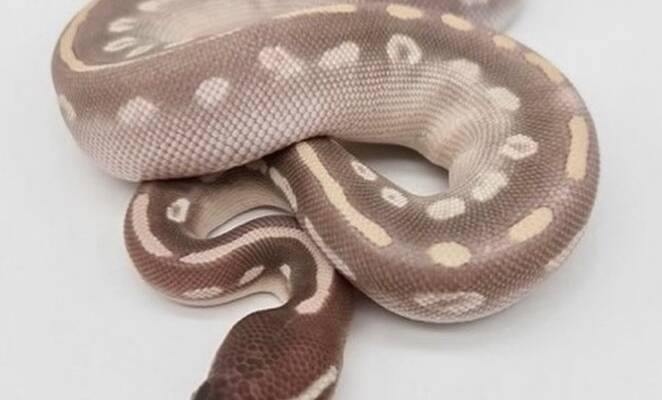Description
Puma Ball Python for Sale – Ranch of Exotic Breeds
Are you looking to add a unique and captivating reptile to your collection? Look no further than the Puma Ball Python! At Ranch of Exotic Breeds, we specialize in providing high-quality, healthy, and genetically diverse exotic pets, and our Puma Ball Pythons are no exception. In this article, we’ll dive into everything you need to know about this stunning morph, including its characteristics, care requirements, and why it’s a must-have for reptile enthusiasts. Plus, we’ve included a helpful FAQ section to answer all your questions!
The Puma Ball Python is a breathtaking morph known for its striking pattern and vibrant colors. This designer morph is a result of careful breeding, combining the best traits of its genetic lineage. With its docile temperament and manageable size, the Puma Ball Python is perfect for both beginner and experienced reptile keepers. At Ranch of Exotic Breeds, we offer healthy, well-cared-for Puma Ball Pythons that are ready to become the centerpiece of your collection.
Why Choose a Puma-Ball Python?
- Unique Appearance: The Puma Ball Python features a mesmerizing blend of colors and patterns, making it a standout addition to any reptile collection. Its sleek, glossy scales and intricate markings are truly eye-catching.
- Docile Nature: Ball pythons are known for their calm and gentle temperament, and the Puma morph is no exception. These snakes are easy to handle and make great pets for reptile lovers of all experience levels.
- Manageable Size: Unlike some larger snake species, Puma Ball Pythons grow to a manageable size of 3-5 feet, making them ideal for home enclosures.
- Hardy and Low-Maintenance: Ball pythons are hardy creatures that thrive in captivity with proper care. Their dietary and habitat requirements are straightforward, making them a low-maintenance pet.
Caring for Your Puma-Ball Python
To ensure your Puma Ball Python thrives, it’s essential to provide the right environment and care. Here’s a quick guide:
1. Enclosure Setup
- Tank Size: A 20-40 gallon tank is suitable for an adult Puma Ball Python.
- Substrate: Use coconut fiber, cypress mulch, or aspen bedding to maintain humidity.
- Temperature: Maintain a gradient of 78-80°F on the cool side and 88-92°F on the warm side.
- Humidity: Keep humidity levels between 50-60%, with a slight increase during shedding.
2. Feeding
- Diet: Puma-Ball Pythons thrive on a diet of frozen-thawed rodents (mice or rats). Feed juveniles once a week and adults every 10-14 days.
- Water: Provide a clean water bowl large enough for soaking.
3. Handling
- Handle your snake gently and regularly to build trust. Avoid handling during shedding or immediately after feeding.
4. Health
- Regularly check for signs of illness, such as lethargy, loss of appetite, or abnormal shedding. Schedule annual check-ups with a reptile veterinarian.
Frequently Asked Questions (FAQ)
1. What is a Puma-Ball Python?
The Puma-Ball Python is a designer morph known for its unique coloration and pattern. It is a result of selective breeding to enhance specific genetic traits.
2. How big do Puma-Ball Pythons get?
Puma Ball Pythons typically grow to 3-5 feet in length, making them a manageable size for most reptile enthusiasts.
3. Are Puma Ball Pythons good for beginners?
Yes! Their docile nature and low-maintenance care requirements make them an excellent choice for first-time snake owners.
4. What do Puma Ball Pythons eat?
They primarily eat frozen-thawed rodents, such as mice or rats. The size of the prey should match the snake’s girth.
5. How long do Puma Ball Pythons live?
With proper care, Puma Ball Pythons can live for 20-30 years in captivity.
6. Do Puma Ball Pythons Snakes for sale require special lighting?
No, they do not require UVB lighting. However, a consistent day-night cycle using ambient lighting is beneficial.
7. Can I handle my Puma-Ball Python?
Yes, they are known for their calm temperament and can be handled regularly. Always handle them gently and avoid stressing the snake.
8. How do I set up an enclosure for a Puma-Ball Python?
Provide a secure tank with proper substrate, a warm side, a cool side, hiding spots, and a water bowl. Maintain appropriate temperature and humidity levels.
9. Where can I buy a Puma-Ball Python?
You can find healthy and well-cared-for Puma-Ball Pythons at Ranch of Exotic Breeds. We prioritize the health and well-being of our animals.
10. Do you ship Puma-Ball Pythons?
Yes, we offer safe and reliable shipping options to ensure your new pet arrives healthy and stress-free.
Why Choose Ranch of Exotic Breeds?
At Ranch of Exotic Breeds, we are passionate about providing our customers with the highest quality exotic pets. Here’s why you should choose us:
- Healthy Animals: Our Puma-Ball python for sale are bred and raised in optimal conditions to ensure they are healthy and thriving.
- Expert Guidance: We provide detailed care instructions and are always available to answer your questions.
- Ethical Practices: We prioritize the well-being of our animals and adhere to strict ethical breeding standards.
- Wide Selection: In addition to Puma Ball python , we offer a variety of other exotic breeds to suit your preferences.
Conclusion
The Puma-Ball Python is a stunning and unique morph that makes a fantastic addition to any reptile collection. With its striking appearance, docile nature, and manageable care requirements, it’s no wonder this snake is a favorite among enthusiasts. At Ranch of Exotic Breeds, we are proud to offer healthy and high-quality Puma Ball Pythons for sale. Whether you’re a seasoned reptile keeper or a beginner, we’re here to help you find the perfect exotic pet.
Ready to bring home your very own Puma-Ball Python? Visit our Corn snake store today or contact us for more information. Your new exotic companion is just a click away at our Reptiles store!





Reviews
There are no reviews yet.